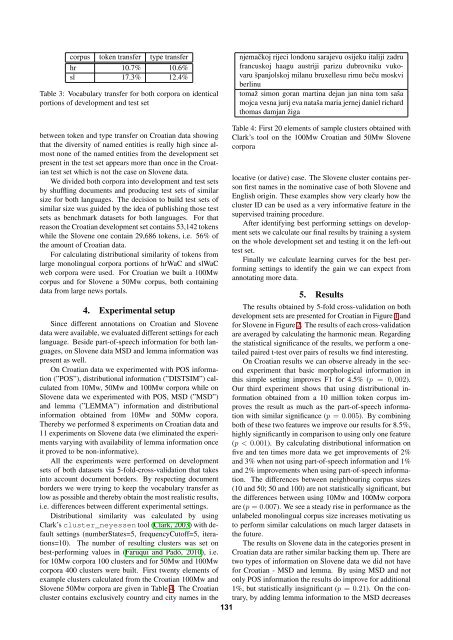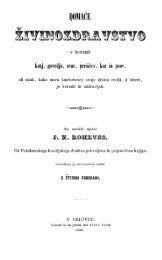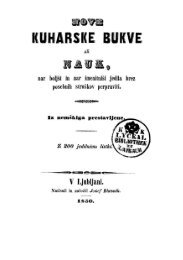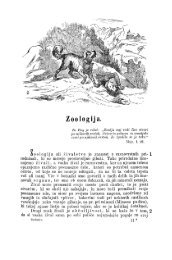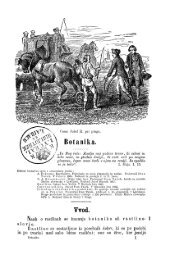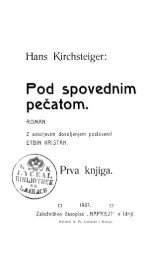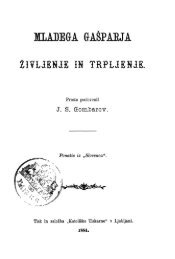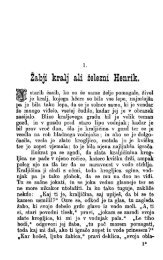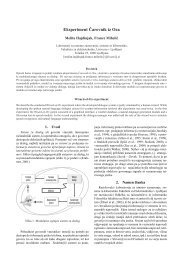Proceedings - Natural Language Server - IJS
Proceedings - Natural Language Server - IJS
Proceedings - Natural Language Server - IJS
Create successful ePaper yourself
Turn your PDF publications into a flip-book with our unique Google optimized e-Paper software.
corpus token transfer type transfer<br />
hr 10.7% 10.6%<br />
sl 17.3% 12.4%<br />
Table 3: Vocabulary transfer for both corpora on identical<br />
portions of development and test set<br />
between token and type transfer on Croatian data showing<br />
that the diversity of named entities is really high since almost<br />
none of the named entities from the development set<br />
present in the test set appears more than once in the Croatian<br />
test set which is not the case on Slovene data.<br />
We divided both corpora into development and test sets<br />
by shuffling documents and producing test sets of similar<br />
size for both languages. The decision to build test sets of<br />
similar size was guided by the idea of publishing those test<br />
sets as benchmark datasets for both languages. For that<br />
reason the Croatian development set contains 53,142 tokens<br />
while the Slovene one contain 29,686 tokens, i.e. 56% of<br />
the amount of Croatian data.<br />
For calculating distributional similarity of tokens from<br />
large monolingual corpora portions of hrWaC and slWaC<br />
web corpora were used. For Croatian we built a 100Mw<br />
corpus and for Slovene a 50Mw corpus, both containing<br />
data from large news portals.<br />
4. Experimental setup<br />
Since different annotations on Croatian and Slovene<br />
data were available, we evaluated different settings for each<br />
language. Beside part-of-speech information for both languages,<br />
on Slovene data MSD and lemma information was<br />
present as well.<br />
On Croatian data we experimented with POS information<br />
(”POS”), distributional information (”DISTSIM”) calculated<br />
from 10Mw, 50Mw and 100Mw corpora while on<br />
Slovene data we experimented with POS, MSD (”MSD”)<br />
and lemma (”LEMMA”) information and distributional<br />
information obtained from 10Mw and 50Mw copora.<br />
Thereby we performed 8 experiments on Croatian data and<br />
11 experiments on Slovene data (we eliminated the experiments<br />
varying with availability of lemma information once<br />
it proved to be non-informative).<br />
All the experiments were performed on development<br />
sets of both datasets via 5-fold-cross-validation that takes<br />
into account document borders. By respecting document<br />
borders we were trying to keep the vocabulary transfer as<br />
low as possible and thereby obtain the most realistic results,<br />
i.e. differences between different experimental settings.<br />
Distributional similarity was calculated by using<br />
Clark’s cluster_neyessen tool (Clark, 2003) with default<br />
settings (numberStates=5, frequencyCutoff=5, iterations=10).<br />
The number of resulting clusters was set on<br />
best-performing values in (Faruqui and Padó, 2010), i.e.<br />
for 10Mw corpora 100 clusters and for 50Mw and 100Mw<br />
corpora 400 clusters were built. First twenty elements of<br />
example clusters calculated from the Croatian 100Mw and<br />
Slovene 50Mw corpora are given in Table 4. The Croatian<br />
cluster contains exclusively country and city names in the<br />
131<br />
njemačkoj rijeci londonu sarajevu osijeku italiji zadru<br />
francuskoj haagu austriji parizu dubrovniku vukovaru<br />
ˇspanjolskoj milanu bruxellesu rimu beču moskvi<br />
berlinu<br />
tomaˇz simon goran martina dejan jan nina tom saˇsa<br />
mojca vesna jurij eva nataˇsa maria jernej daniel richard<br />
thomas damjan ˇziga<br />
Table 4: First 20 elements of sample clusters obtained with<br />
Clark’s tool on the 100Mw Croatian and 50Mw Slovene<br />
corpora<br />
locative (or dative) case. The Slovene cluster contains person<br />
first names in the nominative case of both Slovene and<br />
English origin. These examples show very clearly how the<br />
cluster ID can be used as a very informative feature in the<br />
supervised training procedure.<br />
After identifying best performing settings on development<br />
sets we calculate our final results by training a system<br />
on the whole development set and testing it on the left-out<br />
test set.<br />
Finally we calculate learning curves for the best performing<br />
settings to identify the gain we can expect from<br />
annotating more data.<br />
5. Results<br />
The results obtained by 5-fold cross-validation on both<br />
development sets are presented for Croatian in Figure 1 and<br />
for Slovene in Figure 2. The results of each cross-validation<br />
are averaged by calculating the harmonic mean. Regarding<br />
the statistical significance of the results, we perform a onetailed<br />
paired t-test over pairs of results we find interesting.<br />
On Croatian results we can observe already in the second<br />
experiment that basic morphological information in<br />
this simple setting improves F1 for 4.5% (p = 0, 002).<br />
Our third experiment shows that using distributional information<br />
obtained from a 10 million token corpus improves<br />
the result as much as the part-of-speech information<br />
with similar significance (p = 0.005). By combining<br />
both of these two features we improve our results for 8.5%,<br />
highly significantly in comparison to using only one feature<br />
(p < 0.001). By calculating distributional information on<br />
five and ten times more data we get improvements of 2%<br />
and 3% when not using part-of-speech information and 1%<br />
and 2% improvements when using part-of-speech information.<br />
The differences between neighbouring corpus sizes<br />
(10 and 50; 50 and 100) are not statistically significant, but<br />
the differences between using 10Mw and 100Mw corpora<br />
are (p = 0.007). We see a steady rise in performance as the<br />
unlabeled monolingual corpus size increases motivating us<br />
to perform similar calculations on much larger datasets in<br />
the future.<br />
The results on Slovene data in the categories present in<br />
Croatian data are rather similar backing them up. There are<br />
two types of information on Slovene data we did not have<br />
for Croatian - MSD and lemma. By using MSD and not<br />
only POS information the results do improve for additional<br />
1%, but statistically insignificant (p = 0.21). On the contrary,<br />
by adding lemma information to the MSD decreases


